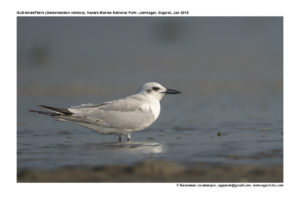Gull-billed Tern

Gull-billed Tern Gelochelidon nilotica
Etymology:
- Gelochelidon : Greek word gelao– to laugh; khelidon- Swallow
- Nilotica: Latin word for “ From the Nile”
Vernacular Names: Kash: Krind, Keru, Pun: Bularhtaheri, Gond: Kivi, Guj: Dhomda-dhomdi, Dholivabagali, Mar: Hivalisurya, KuravChochichaSuray, Ta: Karuppumookuaala, Te: Ramadasu, Samudrapu kaki, Mal: Kadalkakka, Sinh: Muhudulihinia,Mald: Kirru, Dooniamma, Hindi: Nil Tehari
Distribution in India: Widespread winter visitor except North, North West and parts of East India.
Description: Size of 33–43 cm; wt. of 130–320 g; wingspan of 85–103 cm. It is a unique heavy-billed, long-legged tern with slightly forked tail, broad wings and very pale body; all black bill that has sharp gony deal angle, but no terminal hook, resembling that of small gull. The eye is dark brown; crown and nape are black, upperparts including rump pale are grey, primaries are slightly darker but wingtips are whitish to pale grey. The tail and underparts are white. The non-breeding adult is nearly pure white with some dark streaking on hindcrown, and dark patch behind eye. The juvenile has scapulars and upperwing-coverts variably splotched with brown; head is white with fine dark speckling.
Habitat: It breeds on barrier beaches and dunes, salt-marshes, salt-works, man-made islands, and rivers and freshwater lagoons and on hyper saline lakes. It winters on estuaries, lakes and salt-pans.
Food habits: It eats grasshoppers, dragonflies, moths and grubs, spiders, earthworms, desert locusts small reptiles, frogs, small fish ,aquatic invertebrates; mice, voles and small birds. It hawks for insects over estuaries, mudflats, coastal lagoons and agricultural fields and pastures. It flies slowly and then darts swiftly down to seize prey item from surface of ground, water or vegetation. It occasionally pirates food from other terns sharing same colonies. It feeds in large numbers on emerging insects over lakes, fields and grassland. During migration typically feed over salt-ponds, coastal lagoons and mudflats, as well as marshes and wet fields.
Breeding habits: They breed in May–Jun in North America, Europe and N Africa, Apr–May in India, May in China, Apr–Jul in NE Brazil and Oct–Nov in S Brazil. They are monogamous with long-term pair bonds, which may form before arrival on breeding grounds. They nest on sand, shell bars, dry mud, dykes, sea wrack, floating vegetation, waterfowl nests. They prefer elevated ridges or objects. They lay a clutch of 2–3 eggs, laid over 6 days. The incubation period is 22–23 days and incubation done by both sexes. The fledging period is 28–35 days. The parents attend to the young for up to three months.